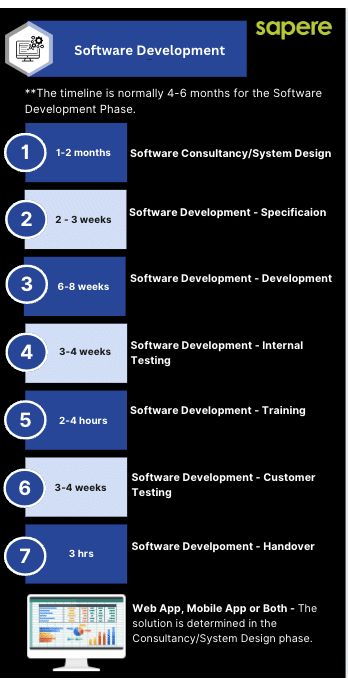
In today’s competitive world, it’s even more important to try and realise the benefits software can bring to streamlining business operations. Whether that’s by replacing/removing:
- paper-based steps in a business
- duplicate steps in a process
- lengthy, time-consuming manual steps in a process
- human error
Or modernising/improving an existing system that might not work as well as it should.
The UK Prime Minister only recently announced (13th Jan 2025) that UK PLC will try to turbo charge productivity using AI tools. The endorsement should be seen as a good thing for the adoption of AI, but this benefit is best realised when the digital infrastructure of a business has a sound foundation.
Here’s the step-by-step approach we use to help businesses benefit from introducing software to provide them with a sound digital foundation.
As we’ve mentioned in a previous blog, step 1 should be the starting point for any business before embarking on any digital improvement efforts—specifically, understanding the need and designing the right solution to address the challenge.
Step 1- Software/System Design – Understanding the need
The purpose of this step is to understand the need — i.e. why you require the support of a digital expert and what challenges you are trying to overcome.
Once we have a clear understanding of the business needs, we assess the current digital infrastructure and system requirements. This allows us to design a web and/or mobile app based solution along with system architecture, system wireframes, a development roadmap, costs, timescales and recommendations.
This information can then be used to develop the solution.
Step 2 – Software Development Phase – Specification
Using the design and wireframes from step 1 a specification document is created which confirms what’s being developed. We also use this step to agree on key milestones and timelines for delivery and ask you to approve the specification by signing it off digitally.
Step 3 – Software Development Phase – Development
Using the signed off specification the development delivery team set about developing the software, which includes:
- creating and designing the database structure
- creating the back-end infrastructure
- creating the front-end infrastructure
- creating the User Interface (UI) and User Experience (UX)
- integrating the solution with third-party systems (Sage, Payment Gateways etc) – where relevant
Step 4 – Software Development Phase – Internal Testing
Step 4 sees the creation of test plans which are used to test the solution’s robustness, security, performance, and accuracy against the specifications, using real data and project information provided by you. The software solution doesn’t move to steps 5 & 6 until it has passed the rigorous testing procedures in place.
Step 5 – Software Development – Training
To ensure your team understands how to use the system as it has been designed, a training session is held with key stakeholders in the business. We run through real-life projects and tasks using the software, so the team becomes familiar with how it should be used. The UI and UX have been designed with ease of use and simplicity in mind, making this step straightforward for users of varying technical aptitude.
Step 6 – Software Development Phase – Customer Testing
Once the solution has passed internal testing and training has been provided the software is passed over to you to undertake you own testing with your own test plans. This is an opportunity to check that the system design and architecture meet the original business objectives defined in step 1.
Step 7 – Software Development Phase – Handover
Once the solution has passed customer testing the software is made live and in the case of a mobile app published on the App stores, this marks the official handover of the solution to you. At this point we remain available for ongoing support and future updates as required.
Conclusion
This structured approach ensures each phase is handled with care, resulting in a product that perfectly meets your business needs.
If you’re ready to enhance your business efficiency and boost productivity with custom software, get in touch today and let’s get started!